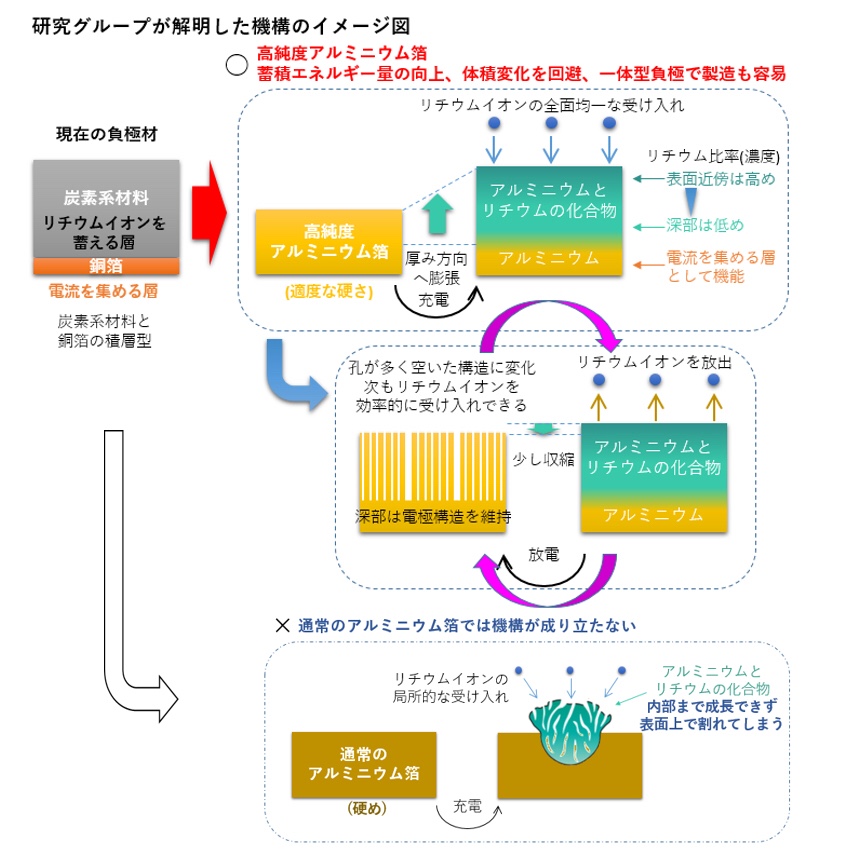
日本LIB:住友化学、アルミ負極材使い高性能化:充放電時体積膨縮を制御(動画):
Japan LIB: Sumitomo Chemical uses aluminum negative electrode material: Controls expansion contraction:
日本LIB:住友化学使用铝负极材料实现更高的性能:控制充放电期间的体积膨胀/收缩
日本のLIB:
2020.05.13
東北大学/住友化学:
「LIB負極材として、アルミニウムを使用した場合の課題」を解決し、その機構を解明しました。
LIB充放電時、アルミニウム負極の体積膨縮を制御できることを見出しました。
今後の電池製造工程の簡素化や高性能化を図ります。
従来、LIBの負極には、炭素系材料が用いられています。
さらなる大容量化のための新素材が登場しました。
部品・素材|
https://www.netdenjd.com/articles/-/232282
東北大学と住友化学、アルミニウム負極の課題であった充放電時の劣化の回避につながる新しい機構を解明
~リチウムイオン二次電池の高性能化につながる新しい負極の実現へ~
国立大学法人東北大学金属材料研究所
住友化学株式会社
ポイント
炭素系負極に比べ数倍のエネルギーを蓄えられるアルミニウム負極について、
課題であった充放電時の体積膨縮を、高純度アルミニウム箔の使用により制御できることを見いだし、その機構を解明した
従来の負極は、リチウムイオンを蓄える機能の炭素系材料と、電流を集め基材の機能も果たす銅箔の積層構造とする必要があったが、
高純度アルミニウム箔の使用により双方の役割を両立する「一体型負極」となることを突き止めた
これらの成果は、電池の製造工程の大幅な簡素化と高性能化に貢献するものである
現在の負極は炭素系材料が主流ですが、
電池のさらなる高容量化のために、炭素系材料に比べて3~10倍のエネルギーを蓄えられるシリコンのほか、スズやアルミニウムなどの金属系材料の使用が期待されています。
しかし、それらの材料は、多くのリチウムイオンを取り込み大きなエネルギーを蓄えられる反面、充放電時に2~4倍も膨縮するため内部の電極構造が崩れやすい点が、実用化の課題となっていました。
今回、本研究グループは、高純度アルミニウム箔の硬さを最適化することにより、課題であった充放電時の体積膨縮の制御が可能なことを見いだしました。
一体型アルミニウム負極の実現により、従来のリチウムイオン二次電池に比べて、電池製造のプロセスを大幅に簡素化できることから、製造工程における環境負荷の低減とともに、高容量化や軽量化、低価格化なども期待できます。
ニュースリリース | 住友化学株式会社
https://www.sumitomo-chem.co.jp/news/detail/20200427.html
Tohoku University and Sumitomo Chemical Reveal a New Mechanism for Preventing Deterioration of Aluminum Anode during Cyclic Battery Reactions
Apr. 27, 2020
Institute for Materials Research, Tohoku University
Sumitomo Chemical, Co., Ltd.
Summary
Discovered that the use of high purity aluminum foil can successfully control the huge volume expansion/contraction of high capacity aluminum anodes during charge/discharge processes, and clarified its mechanism.
Determined that high purity aluminum foil
can be an “integrated anode”, which can replace two components of the conventional graphite anode,
i.e., a layered structure of carbon material (that accommodates lithium ions) and copper foil (that functions as a substrate to collect current) as it plays the roles of both components.
Contributed to higher performance and significant simplification of the battery manufacturing process.
Abstract
Research Assistant Professor Hongyi Li and Professor Tetsu Ichitsubo et al. at Institute for Materials Research, Tohoku University and researchers at Sumitomo Chemical
have jointly undertaken the research and development of novel anodes for higher capacity of lithium-ion rechargeable batteries since April 2019.
This joint research group has successfully elucidated a new mechanism for circumventing the huge volume strain during charge/discharge battery reactions with the use of a high purity aluminum foil alone as anode.
Lithium-ion rechargeable batteries
consist of four components: a cathode, an anode, an electrolyte, and a separator film.
Lithium ions move between the cathode and anode when the battery is charged or discharged; when charging,
the anode takes in the lithium ions released by the cathode, and the reverse when discharging. Carbon-based materials are currently the mainstream for anodes.
However, the use of silicon or metals such as tin and aluminum, has been considered as promising anode materials for high energy-density batteries because these materials can store three to ten times more lithium ions than the same weight carbon-based materials.
Despite the higher capacity for absorbing more lithium ions, the application of metal anodes has been deadlocked because their huge volume changes (two to four times) can destroy the anode’s structure.
News Releases | SUMITOMO CHEMICAL
https://www.sumitomo-chem.co.jp/english/news/detail/20200427e.html
Circumventing huge volume strain in alloy anodes of lithium batteries Article
Published: 13 April 2020
Hongyi Li, Takitaro Yamaguchi, […]Tetsu Ichitsubo
Nature Communications volume 11, Article number: 1584 (2020) Cite this article
Abstract
Since the launch of lithium-ion batteries, elements (such as silicon, tin, or aluminum) that can be alloyed with lithium have been expected as anode materials, owing to larger capacity.
However, their successful application has not been accomplished because of drastic structural degradation caused by cyclic large volume change during battery reactions.
To prolong lifetime of alloy anodes, we must circumvent the huge volume strain accompanied by insertion/extraction of lithium.
Here we report that
by using aluminum-foil anodes, the volume expansion during lithiation can be confined to the normal direction to the foil and,
consequently, the electrode cyclability can be markedly enhanced.
Such a unidirectional volume-strain circumvention requires an appropriate hardness of the matrix and a certain tolerance to off-stoichiometry of the resulting intermetallic compound, which drive interdiffusion of matrix component and lithium along the normal-plane direction.
This metallurgical concept
would invoke a paradigm shift to future alloy-anode battery technologies.
Nature Communications